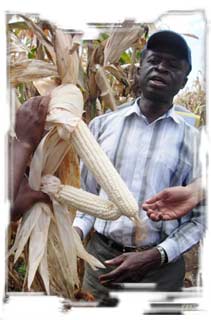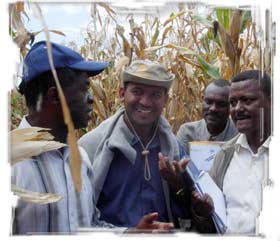CIMMYT E-News, vol 3 no. 11, November 2006
 Ethiopia’s highland maize farmers now have a reason to smile—two reasons, as a matter of fact. Argene and Hora, recently released highland maize varieties, are spurring renewed hope for the country’s agricultural productivity.
Ethiopia’s highland maize farmers now have a reason to smile—two reasons, as a matter of fact. Argene and Hora, recently released highland maize varieties, are spurring renewed hope for the country’s agricultural productivity.
Speaking at a farmer field day held in Bu’i, Oromiya, to showcase the new varieties’ performance, Economic Advisor to the Prime Minister, Neway Gebre-Ab, termed the new varieties “a great breakthrough in research,” and said the future for highland farmers looked bright. “There is great enthusiasm; the farmers told us they were expecting a bumper harvest of 7 to 8 tons per hectare this season,” said CIMMYT maize breeder and coordinator of the Highland Maize Project, Twumasi Afriyie.
For several decades now smallholders cropping the highlands of Ethiopia have wanted new, higher-yielding maize varieties. The cool, wet climate is ideal for the crop, yet varieties released in the 1970s and 80s did not fully exploit the benign climate. Indeed, the older varieties have been giving lower and lower yields in successive seasons. The old varieties also take a long time to mature. Today, many farmers here consume their entire crop green, leaving nothing to mature in the field, and thus risking their long-term food security. This long maturity period also means that farmers can grow only one crop each year.
Since 1998 CIMMYT and partners have been working to develop new, high-yielding maize varieties for the highlands. Thousands of parent lines have been tested and bred in a systematic collaboration with researchers in eastern and central Africa, with the work in Ethiopia being achieved in partnership with scientists at the Ambo National Plant Protection Research Center of the Ethiopian Institute of Agricultural Research (EIAR).
Argene and Hora have also been bred to withstand the important pests and diseases in the highlands. The new varieties mature in fewer days, and are stockier than traditional ones, which easily fall over (lodge) during storms or in strong winds.

Afriyie says Oromiya was a logical first home for the improved highland maize. The expansive state spans parts of western, central and southern Ethiopia, and is home to 26 million people. Nearly 90% are rural folk who depend on agriculture.
Higher maize production can make a real difference to the farmers in the region: The versatile crop can be eaten fresh off the cob or dried and pounded into flour to make different dishes. Poorer households are increasingly adding some maize meal to their injera batter (Ethiopia’s best-loved staple, injera is a spongy, fermented flatbread made from teff flour). This is due to teff’s high price. Surplus maize can be dried and stored for later, or sold for cash.
The farmers who are growing the new varieties plan to capitalize fully on the early maturity. “We can practice relay cropping and get two harvests in a season,” said one woman farmer—another double benefit from the new highland maize.
For more information, Twumasi Afriyie (t.afriyie@cgiar.org)

